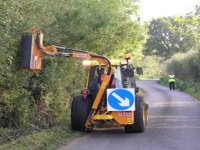Reporting a problem with a hedge
Please use our online reporting form to tell us about a problem with one of our hedges or hedgerows next to a road or footpath. This is the same form used to report issues with our trees.
Also see your responsibilities for trees on your property
Page contents
Hedges on private property
Hedge owners' responsibilities
It is important that owners of land next to the highway ensure their hedges are regularly cut back to the boundary and that trees do not overhang, causing an obstruction of roads and pavements. This is to protect the safety of pedestrians and vehicle users.
If you report issues with a privately owned hedge
If you report an overgrown or an overhanging tree or hedge on private land, we will carry out an inspection. If it endangers or obstructs road and pavement users, we will contact the owner requesting that they cut it back.
If the owner does not take action
If the overgrown tree or hedge is not cut back by the owner within our timescales, we may also serve them with a notice to do the work under Section 154 of the Highways Act 1980.
In some rare cases, if cutting back private hedges would disturb wild birds, we may allow the owners to delay the work until the bird nesting season is over. This is because there are laws against disturbing wild bird nests.
Hedge cutting prior to Highways works on pavements and footpaths
As part of our maintenance programme on road and pavements, you may receive a postcard or letters asking you to cut your hedge back. To ensure that we can carry out the work effectively, the hedge will need to be cut back to the highways boundary please. This means ensuring that the hedge does not overhang the footpath in any way.
Maintaining a hedge regularly, creates a healthier hedge and growth. Sometimes, substantially cutting back hedges that have been allowed to overgrow can result in gaps and sparse looking hedges.
We are sometimes required to cut back hedges on behalf of residents, if there is a safety issue or the overgrown vegetation is preventing works from taking place. In these instances, we are not accountable for the condition that a poorly maintained hedge may be left in, following a cut back to the boundary line.
Hedge cutting on the highway

We are responsible for cutting hedges next to roads and pavements in Surrey to ensure the highway is passable for pedestrians and vehicles and that sightlines are not obstructed. We use a tractor-mounted side-arm flail cutter (pictured right) to cut most highway hedges, a process known as 'flailing'. Some local borough and district councils carry out hedge cutting too.
When we cut hedges
We usually start cutting our hedges in October or November. However, we may sometimes start in September as there are limited contractors who can carry out hedge cutting and they need sufficient time to complete the work across all the areas of Surrey.
We never cut during the bird nesting season (from mid-March to the end of July).
How often we cut hedges
Ideally, hedges should be cut on a two or even three year rotation. For environmental reasons, it is not recommended to cut the same hedge every year except where necessary for road safety or if the hedges contain fast growing species such as ash, sycamore or willow. The reason for this is that most trees and shrubs that form hedges only produce flowers, nuts and berries (such as haws and sloes) on year-old twigs, cutting hedges every year would mean that they would provide less food for insects, birds and mammals.

